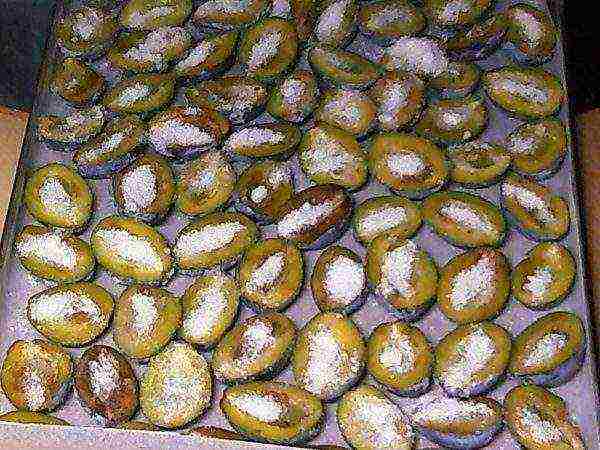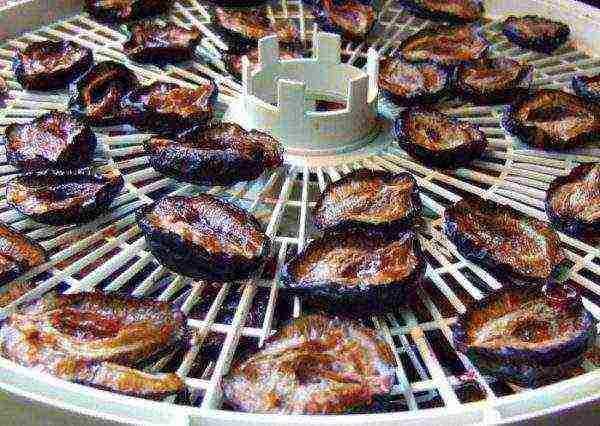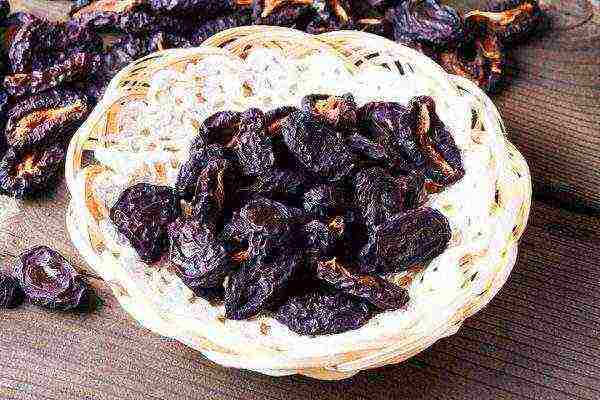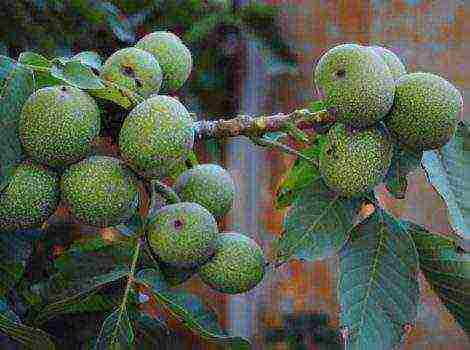Content
Dried plums are called prunes. Properly prepared prunes have excellent taste and are able to retain a huge amount of useful substances.
For the preparation of our favorite dried fruit, not every variety of plum is suitable. Hungarian plums are often used to make prunes.
The Italian Hungarian variety is best suited. The fruits of this variety are large, oval, blue in color with a bluish tinge. This plum is perfect for drying as it has a firm skin and firm flesh. Besides this variety is notable for its low acid content, and there is a sufficient amount of sugar in it.
In addition to the Italian Hungarian, for the manufacture of prunes, Hungarian Azhanska and purple Hungarian are used. Such varieties as Ugorka, Burton and Raisin-eric are also great for drying.
Plums for drying are collected from the ground, but in no case are they taken from tree branches. If the fruit falls off, then it is ripe. Before harvesting, the tree should be shaken lightly so that damaged, rotten, and wormholed fruits fall. The next day, you can already pick up ripe plums.

Preparing plums for drying
Having decided on the choice of a variety for preparing dried plums, you can proceed to the preparatory processing of fresh fruits.
Cooking prunes is not an easy process, as it may initially seem. If you simply dry the plums, then the prunes will not work out of them. The fruit will lose its juice, become too hard and the surface of the fruit will turn brown instead of black. To get a tasty and healthy dried fruit, plums should be carefully prepared for drying.
- Before starting the drying process, the fruits are stored in a covered area in baskets. The volume of fruit in one basket does not exceed 16 kg. Fruits are stored for three days. This is necessary to ensure the softness of the plum, which will later become a property of the prune. If this period is extended, then fermentation processes will begin to occur in the harvested fruits. Naturally, before drying the plums, they are washed well. This is done several times in a row. When the water after washing the fruit becomes clear, then this procedure can be completed.
- Then the plums are sorted, that is, large plums are separated from small ones.... The plums are then checked for tainted fruits that cannot be used to make prunes. At the end of the research procedure, the fruit is thoroughly washed again. But this preparation of the plums for drying is not over yet.
- Next, the blanching procedure is carried out. That is, the fruits are heat treated: they are placed in hot water. This process helps soften the tissues of the fruit, as well as displace air from the plum and increase the size of the cells. In addition, when the fruit is placed in water, oxidative enzymes are broken down. During blanching, only a small amount of ascorbic acid is lost from the important elements. The number of the remaining significant substances remains almost unchanged. But, treatment with water alone is not enough.
- To get rid of the waxy part from the surface of the fruit, an alkaline treatment is used. For such a procedure, a boiling 1% solution of cautic soda is suitable. Plums lie in it for 15 - 20 seconds. But here you need to know that at home, plums may not be completely washed off after processing. Therefore, potash should be used instead of caustic soda. After processing with alkali, the fruit is cooled.

How to make dried fruits in the oven?
To prepare prunes in the oven, the plums are blanched, then washed with cold water and left to dry on a towel. If the fruit is cut into two parts, then the blanching procedure is not carried out. Drying fruits in the oven consists of three stages at different temperatures.
- At the first stage, the oven is heated to 50 ° C, a baking sheet with fruits is placed in it for 5 hours. After that, the plums cool down for the same period of time.
- At the next stage, the plums are turned over and dried for 5 hours in an oven heated to 70 ° C.
- At the last stage of drying, the temperature rises to 75 ° C. Here the fruit is already cooked to full readiness.
Cooking prunes in an electric dryer
To obtain prunes in an electric dryer, after blanching, the plums are placed on a pallet in one layer. If the fruits are divided in half, then they are laid with the cut up. The drying process in this way also takes place in 3 stages at certain temperature conditions:
- the first 3-4 hours the fruit is dried at a temperature of 45-55 ° C;
- then the plums are dried at a temperature of 60 degrees for 6 hours;
- the final stage - the fruits are put to dry for 6 hours at a temperature of 75–80 ° C.
After the completion of each stage, the pallets are taken out of the dryer for several hours to cool the future prunes.

Drying plums in the sun
The fruits are naturally dried on sheets of wood. The fruit halves, separated from the seeds, are laid out on a sheet not very close to each other, with a cut upward, so that they do not lose juice during drying. Depending on their size, plums should be exposed to the sun for 4 to 5 days.
It should be observed that insects do not land on the fruit. Otherwise, harmful microorganisms may appear in dried fruits.
At night, plums are brought into the house, and in the morning they are taken out into the fresh air after dew has fallen so that mold does not form on them. When drying, the plums are turned over from time to time so that they dry evenly on each side. After drying under the rays of sunlight, the fruit is dried in a shaded place for another 3-4 days.
The readiness of prunes is checked according to certain criteria:
- when you press on the fruit, no breaks appear on them and no juice flows out;
- the fruits are elastic and firm, but at the same time they do not crumble if you press them;
- prunes do not stick to fingers.
Ways to store prunes at home
It is absolutely not difficult to keep prunes in your home. To do this, you just need to follow some simple guidelines. To store this dried fruit, use linen bags and paper bags, wooden boxes with good ventilation, tightly closed containers or glass, metal and plastic containers with a sealed lid.
Store at room temperature in a container with a sealed lid
Prunes can be stored in glass and ceramic jars with a tight-fitting lid for up to six months.
- First of all, the container is prepared. It is thoroughly washed, poured over with boiling water and dried.
- Then dried fruits are placed in it, closed tightly with a lid and placed in a cool place.
- If the prune is wet, then it should be dried.
- Periodically it is necessary to monitor the condition of the dried plums.
Storing dried plums in linen bags and paper bags
Some people store dried fruits in linen bags. But only if there are no harmful insects in the house, such as ants or cockroaches.
Dense cloth bags are soaked in strong saline solution. Then they are well dried, put prunes in them and tied.
The paper bags are filled and closed in the same way. Thanks to fabric and paper, dried plums can breathe, and they also become moldy and retain all their useful qualities.
The only drawback of this storage method is the impossibility of placing prunes near very smelling products: coffee, spices, tobacco.

Storing prunes in the refrigerator
If high humidity prevails in the room, then the dried fruits are stored in the refrigerator. For this:
- Thoroughly sort out the prunes, separate the damaged fruits.
- Packaged in small portions in a glass container with a tight-fitting lid, containers or bags with a zip-fastener.
- Placed on a shelf, refrigerator door or fruit compartment
- Check the moisture in the container once a week. If it appears, the fruits are dried.
Proper storage of dried plums will preserve all of its important properties.
Naturally, you can protect yourself from unnecessary trouble and buy prunes in the market or in a store. But when there is an opportunity to cook prunes at home, you should not expose yourself and your family to possible negative consequences.


